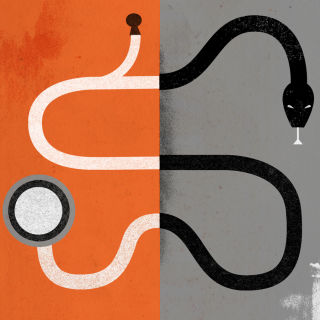
For the past two years, researchers in Hong Kong interviewed the parents of three hundred and thirty-four adolescents about the aggressive and antisocial behavior of their children. Did the kids hurt others to win a game? Were they concerned about the feelings of their peers? The scientists also measured the heart rate of the children and found that low resting heart rate (L.R.H.R.)—usually an indicator of good cardiovascular health and the envy of distance runners and endurance athletes—was linked to bad behavior.
Adrian Raine, the lead author of the Hong Kong study, which appeared in the July issue of the journal Aggressive Behavior, has been examining this odd correlation since 1977, when he studied a group of fifteen-year-old boys and found that those with a low heart rate were more likely to be convicted of crimes. Since then, Raine, a criminologist and psychologist at the University of Pennsylvania, and the author of “The Anatomy of Violence,” has become an expert on L.R.H.R. and other possible biological markers of antisocial behavior, such as brain size and neurotransmitter levels.
He says that it’s still not clear how the trait is connected to bad behavior. “We’ve established that the link exists,” he says. “But we haven’t nailed down why.”
There are several theories, but Raine tends to favor the fearlessness hypothesis, which says that some of those with L.R.H.R. remain undaunted by the threats that would keep most of us in check. When you get scared, your heart rate goes up, because your body activates to deal with the imminent hazard. By definition, people with less fear tend not to get activated in situations that others find threatening.
“These people don’t learn that it’s wrong to be aggressive,” Laura Wilson, a research psychologist at Virginia Tech University who has studied the topic, told me. “They don’t fear consequences. They don’t get sculpted into the law-abiding citizens that most people become.”
Another possibility is that people with L.R.H.R. are chronically under-aroused. “Having a low heart rate can be uncomfortable. It kind of feels like boredom,” Amy Gower, a psychology researcher at the University of Minnesota, says. “To relieve that, some people seek stimulation through aggression.”
Raine’s skeptics argue that L.R.H.R. and other biological factors play a relatively minor role in determining who becomes a criminal. “The evidence is pretty consistent that biological traits don’t have a large effect,” Robert Sampson, a social scientist at Harvard University who has studied the topic for more than two decades, told me. “Social and environmental characteristics have much more weight.” He notes that crime rates vary widely from country to country (Spain’s murder rate, for instance, is twenty-five times lower than Brazil’s, and four times lower than in the United States), even though the biology of humans in those countries differs very little. Sampson says that L.R.H.R. may not be biological but, rather, the result of the same environmental factors that lead to crime: some people may adapt to chronic stress with a lower heart rate.
Raine suggests that L.R.H.R. might be used to help predict future risk among criminals. Information about heart rate might help when deciding whether a prisoner should be released early, or which sort of prison best fits a particular offender. If this idea, in which the fate of a prisoner would be determined in part by biological data, evokes thoughts of eugenics, Raine, whose research on so-called “neurocriminology” has been controversial for decades, acknowledges that the proposal does, in fact, bring up difficult issues about science, probability, and social control. He agrees that L.R.H.R. is far from the sole determinant of criminality; his review of the research indicates that the trait accounts for about five per cent of all antisocial behavior (and that the rest can be explained by social and biological factors such as upbringing, neighborhood, education, income level, brain chemistry and structure, and so on). L.R.H.R. should be seen, Raine says, as a potential warning sign rather than a definitive mark of inevitable criminality. “Low heart rate is one piece of the jigsaw puzzle,” he says. “It’s not the whole story, but it’s not trivial either.”
http://www.newyorker.com/tech/elements/calm-hearts-bad-behavior
 For the past two years, researchers in Hong Kong interviewed the parents of three hundred and thirty-four adolescents about the aggressive and antisocial behavior of their children. Did the kids hurt others to win a game? Were they concerned about the feelings of their peers? The scientists also measured the heart rate of the children and found that low resting heart rate (L.R.H.R.)—usually an indicator of good cardiovascular health and the envy of distance runners and endurance athletes—was linked to bad behavior.
For the past two years, researchers in Hong Kong interviewed the parents of three hundred and thirty-four adolescents about the aggressive and antisocial behavior of their children. Did the kids hurt others to win a game? Were they concerned about the feelings of their peers? The scientists also measured the heart rate of the children and found that low resting heart rate (L.R.H.R.)—usually an indicator of good cardiovascular health and the envy of distance runners and endurance athletes—was linked to bad behavior.